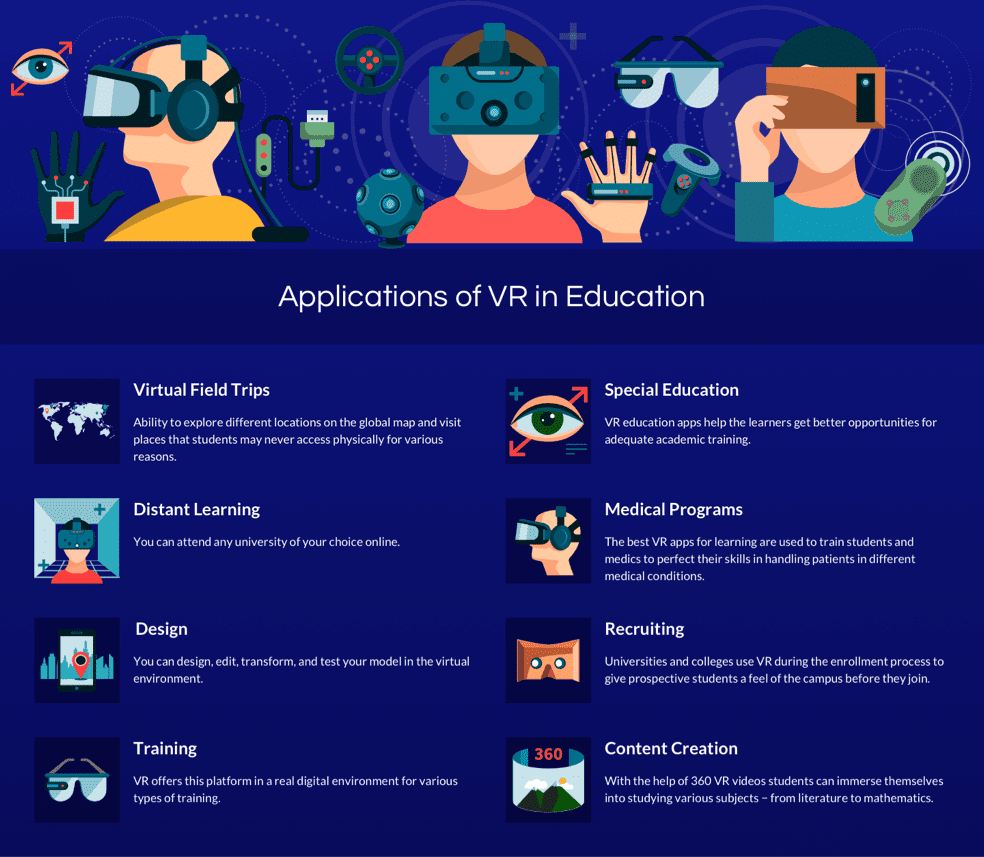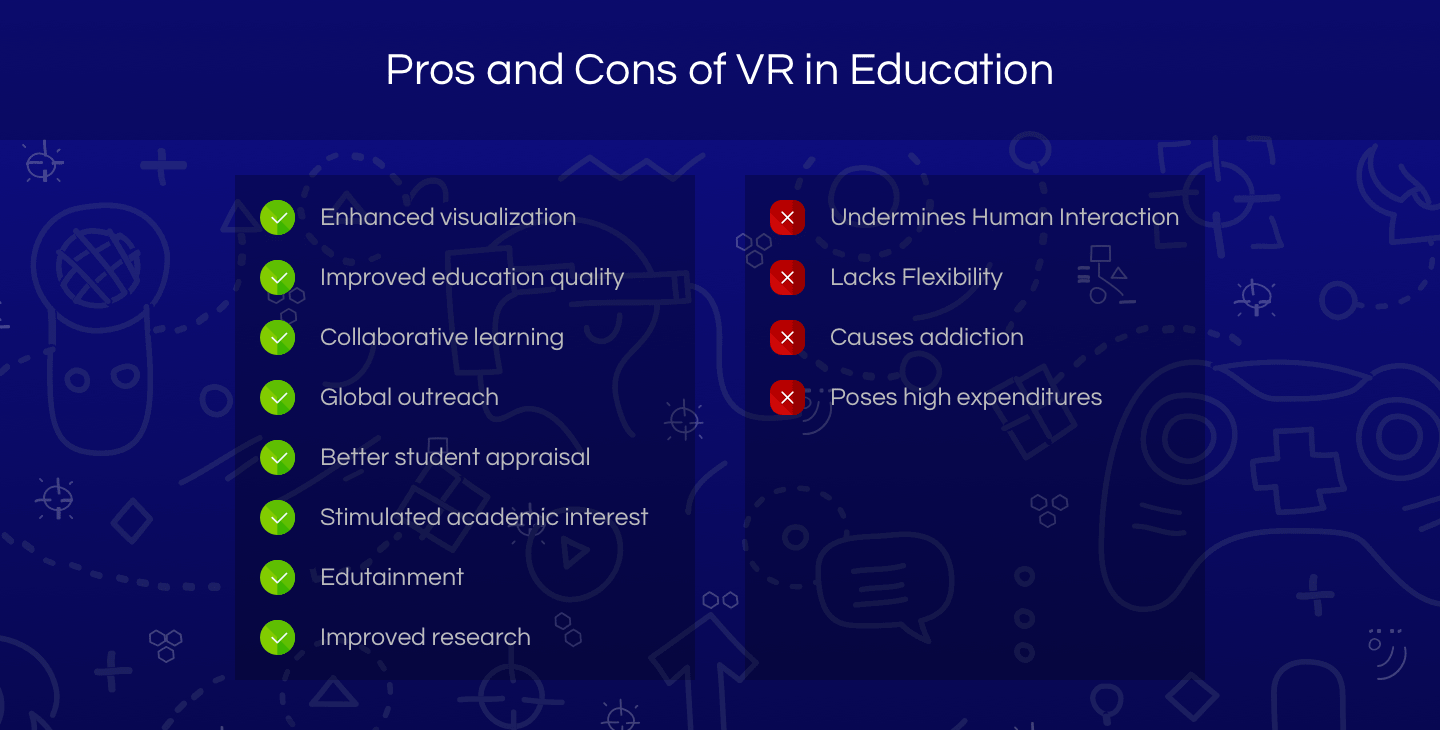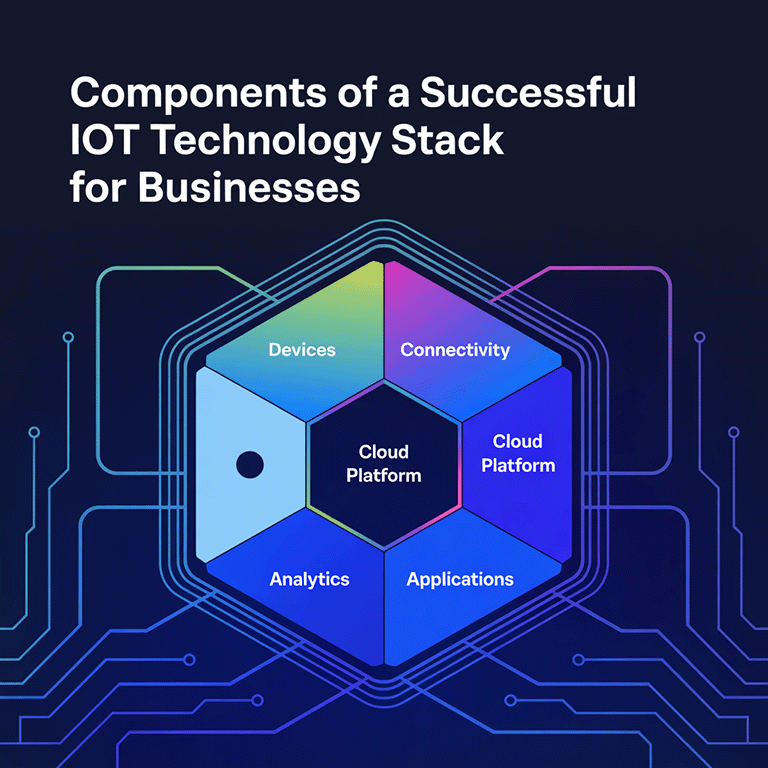Imagine a student soaring through the Colosseum at the height of its glory, witnessing firsthand the roar of the crowd and the clash of gladiators. Or picture them dissecting a virtual frog, observing its organs in intricate detail without the mess or ethical concerns. This is the immersive world, brimming with potential, that Virtual Reality (VR) promises to bring to education.
A whopping 68% of teachers, according to Mindshare Learning, are chomping at the bit to bring VR into their classrooms. But is this technology truly a game-changer for learning, or is it just another shiny gadget with hidden drawbacks?
We navigate the exciting potential and possible pitfalls of VR in education, equipping you with the knowledge to decide if it’s the right fit for your learning journey.
How Does Virtual Reality Change the Education Industry?
Although most education systems still impart knowledge to students through the trite ways of reading and listening to tutors, some have adopted educational VR and reap the benefits of such innovation. It has a positive impact on both the learners and facilitators.
With modern tech devices, students can once again feel alive and eager to learn in a virtual environment. Being a new concept, it motivates the learners to achieve better grades since VR simulations are effective and realistic. Teachers will no longer be boring theoretical robots. This technology takes them to new heights since learners can now explore the practical side instantly in a rich virtual environment.
VR provides a safe platform for risky learning procedures such as chemical experiments, aviation, and medical manipulations. It enhances cooperation and collective learning since students have the freedom to explore this new tech environment, unlike in a conventional classroom. Virtual reality and education go hand in hand in improving the learning process.
A Comprehensive Look at Current Virtual Reality Hardware
Virtual reality (VR) has evolved from a futuristic dream to a tangible reality, like artificial intelligence (AI), transforming how we game, learn, and experience the world. But before diving into the immersive depths of virtual reality technology let’s explore the hardware that makes it all possible.
Headsets: The crown jewel of VR, headsets are your window to virtual worlds. Popular options include:
- Tethered headsets: These require a connection to a powerful computer, offering high-resolution visuals and powerful processing. Examples include the Valve Index and HTC Vive Cosmos Elite.
- Standalone headsets: These offer portability and convenience, with built-in processing and no PC needed. Examples include Oculus Quest 2 and Meta Quest Pro.
Controllers: How you interact with virtual worlds is crucial. Common controller options include:
- Motion controllers: These mimic your hand movements, allowing you to grab, interact, and manipulate objects in VR.
- Gamepads: Traditional gamepad controllers offer familiar button layouts for a comfortable gaming experience.
- Touchpad controllers: These offer a more compact and intuitive way to navigate and interact within VR environments.
Tracking Systems: To accurately track your movements in VR, different technologies are used:
- Inside-out tracking: Cameras embedded in the headset track your head and controller movements, eliminating the need for external sensors.
- Outside-in tracking: External sensors track your position and movements, offering greater accuracy for larger play spaces.
Accessories: Enhance your VR experience with various add-ons:
- Haptic gloves: Provide realistic touch feedback, letting you feel virtual objects and surfaces.
- Treadmills: Allow you to walk or run in VR, adding another layer of immersion.
Scent generators: Simulate real-world smells, further immersing you in virtual environments.
Exploring the Uses of Virtual Reality in Education
Virtual reality in education and training is taking center stage as most learning institutions are embracing the use of computer-generated software to teach practical lessons. To make studying experiences better, developers created the best educational VR apps for you like Anne Frank VR House, Discovery VR, and much more.
But Virtual Reality provides many educational benefits for various areas. So, let’s describe them in detail!

Virtual Field Trips
The most popular application of virtual reality in education is the ability to explore different locations on the global map and visit places that students may never access physically for various reasons. For instance, a history class can take students to virtual sites that will give them a real experience they would never achieve in a traditional classroom.
Special Education
Some students require special attention due to physical disabilities or mental incapacities. Therefore, VR education apps help learners get better opportunities for adequate academic training. They can study and explore endless possibilities through the headset. Since it uses sight and sound, the students are in a better position to remember each lesson.
Dive into our case study now for valuable insights and inspiration in education.
Medical Programs
A significant portion of investments in Virtual Reality for education focuses on medical schools and hospitals. Here, the best VR apps for learning are used to train students and medics to perfect their skills in handling patients in different medical conditions such as surgeries and other sensitive procedures standing no errors or imperfections. The simulations play a significant role in preparing both doctors and nurses to lessen the margin of error through frequent practice.
Content Creation
Today, most VR courses cover the fields of history and science-related subjects. However, the computer-generated format applies to other themes and learning areas. It can be used to create content that improves the classroom experience in any subject. For instance, with the help of 360 VR videos, students can immerse themselves in studying various subjects—from literature to mathematics.
Distant Learning
Advances in technology and the growing Web connectivity have made the world a small global village. Now, with virtual reality in education, you can attend any university of your choice online. It offers not only convenience but also a real classroom experience. Now it is quite an expensive affair but in the future, virtual distance learning has massive potential, and it will be a serious competitor to the conventional system of education.
Training
Practical VR-enriched projects provide a solid learning experience by giving students a deeper understanding of a particular subject. Thus, VR offers this platform in a real digital environment for various types of training. It applies to both educational and professional training sessions.
Design
Virtual reality education apps in the design field are a dream come true. They take modeling to another level by enabling students to create images in 3D prototypes. With intricate details and distinct features, you can design, edit, transform, and test your model in the virtual environment. It is an exciting experience for designers since it offers a boundless platform for exploration in a virtual world.
Recruiting
Universities and colleges use VR during the enrollment process to give prospective students a feel of the campus before they join. It helps students get first-hand experience regarding the learning environment and hence plays a role in their decision-making.
Advantages and Disadvantages of Virtual Reality in Education
Virtual Reality changes the entire traditional learning process into an exciting and intriguing experience. It breaks down the four walls and ceilings of a classroom to expand the education system to a liberating digital environment.
However, it’s important to recognize that modern technologies often have both advantages and disadvantages. Therefore, when integrating technology into your processes, it’s crucial to consider all potential aspects. We’ve compiled a comprehensive list of both the pros and cons to help you make an informed decision.

VR in Education Pros
This game-changing technology isn’t just about flashy headsets and futuristic gimmicks; it’s about creating immersive experiences that captivate students, ignite their curiosity, and propel them deeper into the heart of knowledge.
But what exactly makes VR such a boon for education? Let’s explore the vast arsenal of benefits it brings to the classroom.
-
- Enhanced visualization
VR is by far the most advanced technology that heightens visualization by alternating different experiences and realities. It is an effective way of exploring diverse subject areas and places you can never visit with unreachable objects such as the Moon or Jupiter. Virtual reality in education makes the impossible happen by making it seem real.
- Improved education quality
Pictures make learning easier; thus, VR offers students an in-depth understanding of different subject areas. The immersive learning experience facilitates better retention of the educational material due to the VR simulations. Ultimately, it greatly impacts the quality of education across the board.
- Collaborative learning
Today, learners find the traditional classroom setting quite dull. VR integration is an effective method of sparking the interest of learners and enhancing their learning experience. It will also reduce smartphone addiction among the millennial generation and help them focus on studying.
- Global Outreach
VR is an international platform with no language barriers. The developers incorporate multi-language support into the software; thus, any international students can have an equal opportunity to learn via VR apps.
- Better student appraisal
The conventional system of education thrives on timely and constructive feedback. VR, on the other hand, rewards performance and trials no matter how small. It adopts the gaming reward system to motivate good performance.
- Stimulated academic interest
Students of all ages prefer video content to reading. So, VR in education spurs curiosity and enthusiasm by delivering relevant video content in a student-friendly form.
- Edutainment
VR technology incorporates fun in the classroom. Sitting and learning new information from interesting videos and stunning 3D visuals is not challenging. Entertainment in learning is a plus since students will be more eager to learn and participate in all the lessons interactively. It will boost their overall performance since they enjoy what they are doing.
- Improved research
Virtual Reality is a powerful tool for enhancing research in diverse fields such as medicine. With advances in medical science and education, VR plays a vital role in coming up with improved solutions for disease management and health interventions.
VR in Education Cons
While VR technology has the potential to revolutionize various industries and enhance user experiences, it is essential to acknowledge and address the challenges and limitations it presents.
- Undermines Human Interaction
VR is a modern technology that affects human interaction. It encourages one to live in a virtual world without communicating with other people instead of interacting in a traditional way to hone interpersonal skills.
- Lacks Flexibility
In a VR setting, you cannot ask questions freely when you don’t understand a particular subject area. Learning processes are different for each student since the intellectual capacity is not the same. Thus, it lacks the flexibility that a conventional classroom setting with live teacher-student collaboration offers.
- Causes addiction
VR in education is addictive like other technological devices, and there is a possibility of more students falling into the hole of addiction. If what learner experiences in the virtual world is better than reality, they will tend to gravitate towards VR all the time.
- Poses high expenditures
Modern technology is quite expensive, so it hasn’t reached many people across the globe. It requires massive funding to cut across all the education system levels. For now, it is a tool that only a few can afford, which adds to the educational inequalities rather than erases them.
- Teacher Training and Integration
Effectively integrating VR into the curriculum requires extensive training for teachers to utilize the technology effectively and develop engaging and meaningful learning experiences. Lack of proper training can hinder VR’s potential and even lead to negative learning outcomes.
- Accessibility and Equity
Ensuring equitable access to VR requires addressing affordability, disability considerations, and potential cultural biases within VR content. Failing to do so could inadvertently widen existing educational gaps and perpetuate inequalities.
Wrapping Up
By stepping away from static information and into interactive experiences, virtual reality in education fosters active participation, not passive consumption. Students become explorers, dissecting virtual frogs or soaring through ancient civilizations, igniting their curiosity and deepening their understanding in ways a textbook simply cannot.
However, embracing VR’s potential requires thoughtful consideration. Costs remain a significant hurdle, necessitating creative solutions and strategic investments in educational settings. Additionally, educators themselves need dedicated training to unleash VR’s true impact. A clunky, poorly designed VR experience can hinder learning instead of enhancing it.
In case you have a Virtual Reality project in mind but lack experienced VR developers, contact LITSLINK, a software development company in the USA, and we will transform your idea into reality.




